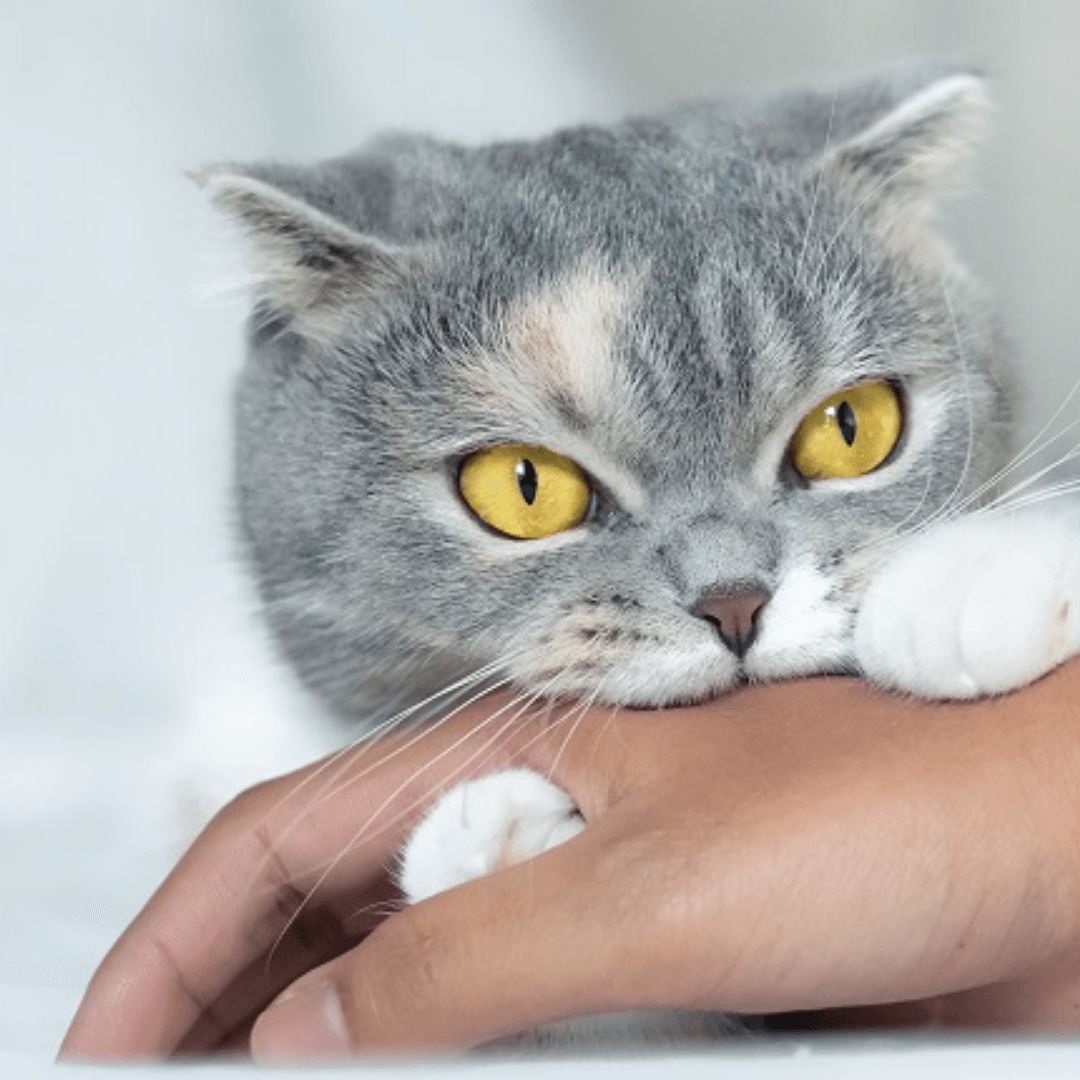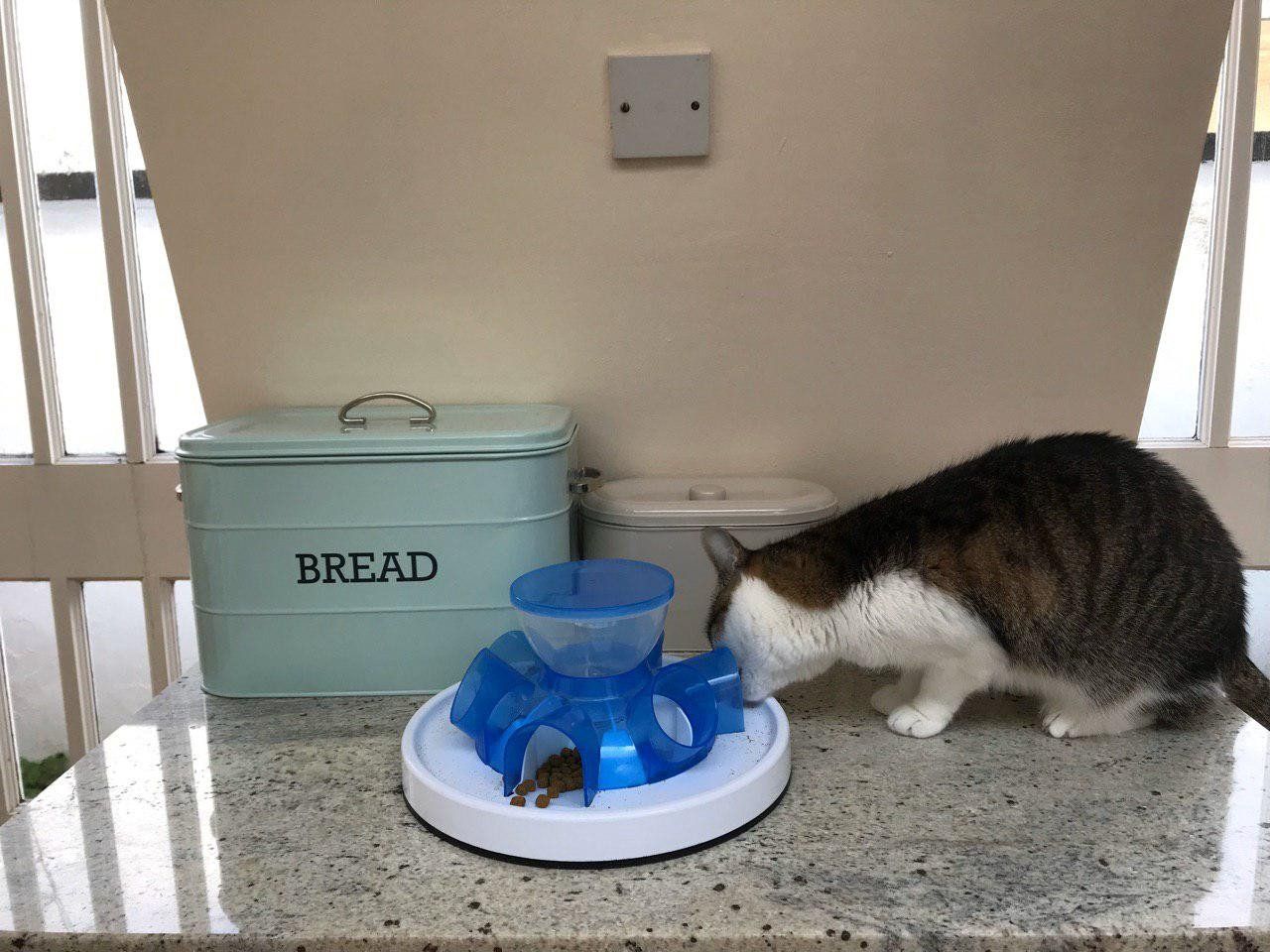Pheromones
are a subclass of semiochemicals, in concrete, fatty acids that are used for communication inside one specie, what we call intra-specific. These fatty acids induce changes in the limbic system and hypothalamus and appear to alter emotional states in cats (1). In short and easy: pheromones are substances that cats use to communicate
between them.
When we say communication we assume that there is the “sender” and the “receptor”, and the sender cat expects a response from the receptor cat. For this reason, cats must be able to detect pheromones, and they are. They have a special organ to perceive and understand these messages left from other cats.
This organ is called Vomeronasal Organ (abbreviated to VNO, and sometimes known as the Jacobson’s organ) it consists of a pair of fluid-filled sacs which are located within the hard palate. As the location is a bit difficult to reach for these molecules (pheromones), cats will use the “Flehmen” response to facilitate this process.
Flehmen is a specific, very peculiar posture, that cats (and many mammals) will adopt to detect the pheromones. The most known example, in another mammal, is the horse or the donkey, when they retract the superior lip and show the teeth with the mouth a bit open. Can you imagine a horse in this posture? Cats do the same.
The pheromones are produced in specialised glands. Cats have glands around the body to produce different types of pheromone, with different communication aims. The locations of the glands are (see pictures above and below):
Pink:
the area between each ear and the eye where the fur is sparse (temporal or periaural glands).
Blue:
the margins of the lips (perioral glands).
Yellow:
under the chin (submandibular gland).
Green:
the cheeks (cheek glands).
White:the base of the tail and extending along the tail (caudal glands).
Purple:
plantar pads on the feet (plantar pad glands).
Orange: the area around the urinary and genital organs (urogenital area) which leads to the production of pheromones in urine.
Dark blue: the area around the anus, perianal area (which includes the anal glands) which leads to the production of pheromones in faeces.
Red:
the area surrounding the teats (intermammary sulcus) in females.
There are different types of pheromones, and each one has a specific function, as described below. Knowing each pheromone and its function, scientists have developed synthetic copies of some of the known pheromones to help cats in different situations. We can find some of them in spray solution, and others as plug in diffusers.
Facial pheromones (F). Can be divided in 5 subgroups:
F1:
Unknown function
F2:
Associated with sexual behaviour.
F3:
Associated with territorial behaviour. I’d like to talk a bit more of this one, because is the most used for humans to reduce cat’s stress, and it is been proved to work.There are different brands offering this product, but for example
Feliway Classic (Ceva):
Use of Feliway has been associated with increased grooming and food intake in hospitalized cats (1) decreased urine spraying (2) and decreased scratching (3). F3 makes them feel safe, because they can associate these scent as “home”.
F4:
Associated with maintaining group cohesion in group-living cats. It can help to maintain the harmony at home or to introduce a new cat at home.
F5:
Unknown function.
Body pheromones (colours from the picture above):
- Maternal appeasing pheromone (Red) (from the mammary sulcus). Many mammals produce this type of pheromones when nursing their young. Feliway (ceva) also offers this synthetic pheromone, known as “Feliway friends”, only available in plug-in diffuser. This one is for multicat houses, helps the cats get along at home and to maintain constant harmony.
- “Scratching” pheromones (Purple): the pheromones left form the plantar pads when scratching are used to send territorial messages. Ceva has also this synthetic pheromone, “feliscratch”. This one can help to redirect our cat to use the scratcher post and avoid other undesired locations.
- “Faeces” pheromones: it is know that cats can exhibit a behaviour called “Middening” that consist in the deposition of faeces without any burying and often in a prominent location. This behaviour makes us think that this behaviour can play a communication roll. It is known, that the faeces are covered by the content of the anal glands, and part of this are pheromones.
And just before finishing I’d like to explain that we cannot perceive cats’ pheromones, because as I said above, are intra-specific substances. Even that we cannot detect them, when cats rub against us, they leave their scent which can be detected for other cats in the future.
Do you need professional help with your cat? Check my
website.
You can join our
instagram
community to learn even more about cats :)
References:
1. Griffith C, Steigerwald E, Buffington C: Effects of a synthetic facial pheromone on behavior of cats, J Am Vet Med Assoc 217:1154, 2000.
2. Mills DS, White JC: Long-term follow up of the effect of a pheromone therapy on feline spraying behaviour, Vet Rec 147:746, 2000.
3. Pageat P, Gaultier E: Current research in canine and feline phero- mones, Vet Clin North Am Small Anim Pract 33:187, 2003.

Today I want to introduce this wide topic, I will cover the main causes of a cat biting you and how can we prevent it from happening. There are many causes of a cat biting you, you need to ask yourself why? (see summary pictures below) 🔸Attention seeking 🔸Inappropriate or predatory play 🔸Associated with petting 🔸Disease or pain related 🔸Redirected aggression 🔸Anxiety/fear or phobia related

Hello Catlover! You wanted a post about homemade diets (including BARF, raw, cooked...) and I tried to avoid it, because I don't have experience with this kind of food; but I'm here to help you understand cats and their needs, so there we go.
BARF means Biologically Appropriate Raw Food, and it was proposed in 1993 by the veterinarian Ian Billinghurst . But I would like to include as alternative diets, those homemade (including cooked and raw meat sources). 🥩In the lasts years, the interest for this kind of diets is growing because of some potential benefits to our furry friends, such as healthier coats and skin, cleaner teeth, reduced faecal odour, etc. and the aim to move to a more natural diet. Although changes may be anecdotally reported by pet owners and veterinarians, potential health benefits have not undergone scientific evaluation (1). Hopefully, as it is a growing practice, further studies will come soon.
😈But not everything is good from BARF diets or Homemade diets, there are many potential risks: 🦴Nutritional concerns: Poor balanced commercial diets of raw food (2, 3). ⚠️Safety risks: risks of contamination with pathogens, such as salmonella, and many others (1, 4, 5). Shedding of these organisms by pets is a risk factor for infection of humans (zoonosis), especially those with immunity problems, elderly people or children and pregnant women (1) 🛑Other risks from diets containing bones: fractured teeth and gastrointestinal injury.
✳️Cooking destroys potential pathogens, but also some nutrients from the food! Alternative diets with cooked meat will ALWAYS need supplementation.
✅If you decide to feed your pet an alternative diet based on meat and bones, do it right: - Always consult with a nutritionist or veterinary nutritionist for a personalised balanced diet according to your cat's lifestyle, life stage and requirements. - Use products intended for human consumption; if possible, use food from your region (Km0 or proximity food). - Hygiene is extremely important when feeding raw food! Wash your hands, surfaces, knives, food bowls, etc. before and after touching the food. - Freezing food can kill some parasites, but it doesn't kill bacteria (it only stops the growing): cooking the food kills pathogens, but it also destroys nutrients and vitamins! If you cook it, you will always need supplementation! ❗️Although AVMA (American Veterinary Medical Association) doesn't recommend it ; and recently in the UK, cats with TUBERCULOSIS from eating raw food have been reported! I’d love❤️ your feedback about this polemic post! What do you feed your cats? Let me know in comments! Do you know anyone feeding their cats “alternative diets”? share the post! Please leave all the questions in comments, and everybody can see the answer ☺️ References: 1.Freeman LM, et al. Current knowledge about the risks and benefits of raw meat–based diets for dogs and cats J Am Vet Med Assoc 2013, Vol. 243, 11: 1549-1558 2. Sarah A. Wilson et al. (2019) Evaluation of the nutritional adequacy of recipes for home-prepared maintenance diets for cats. J Am Vet Med Assoc 254:10, 1172-1179. Online publication date: 30-Apr-2019. 3. Freeman LM, Michel KE. Evaluation of raw food diets (Erratum published in J Am Vet Med Assoc 2001; 218:1716). J Am Vet Med Assoc 2001; 218: 705–709. 4. KuKanich KS. Update on Salmonella spp contamination of pet food, treats, and nutritional products and safe feeding recommendations. J Am Vet Med Assoc 2011; 238: 1430–1434. 5. LeJeune JT, Hancock DD. Public health concerns associated with feeding raw meat diets to dogs. J Am Vet Med Assoc 2001; 219: 1222–1225. If you want to know more about feline nutrition you can have a look at this posts: - What's best wet or dry food? - How to choose the right wet food for your cat? or the right diet for strict carnivores - How much should I feed my cat? - How do you feed your cat ? - Senior cat diet or kittens and food - Choosing a cat feeder

I'd like to approach to toxoplasmosis disease because this one can affect cats and humans. Unfortunately, I've found myself many times in the situation where one of my clients wants to get pregnant or is already pregnant and their doctor says: "Get rid of your cat". Do you know that you can acquire toxoplasmosis without having a cat? and even being vegan? Before reaching this point, I need to make you understand how this toxoplasmosis works (have a look to the picture above). Toxoplasmosis is a disease caused by Toxoplasma gondii, an intracellular obligate parasite (coccidian) (1). The cat is the definitive host, it means, that even that this parasite can survive inside other animals (included human being), it only will be able to reproduce (sexually) inside the cat. That's why when we think about toxoplasmosis, we relate this disease with cats. But how can a cat acquire Toxoplasmosis ? There are two different ways: (To understand better, check the image) - Eating contaminated meat with Toxoplasma cysts (mice, rats, rabbits…) - Eating directly the "eggs" (oocysts) when grooming another infected cat or eating from contaminated surfaces. (When a cat is already infected, will get reinfected grooming itself). How is toxoplasmosis in cats? In healthy adult cats the clinical signs of infection are uncommon (2). Cats that develop clinical disease often have an episodic course with vague signs (3), that will depend on the body system affected. This disease can be riskier (even fatal) in a kitten or in a combination of other diseases such as FeLV, FIV, FIP… When we treat infected cats, our main goal is to reduce the shedding of oocysts and to control the clinical signs. But unfortunately, there is no drug to clear all the tissue cysts, so cats can remain infected for life (that is not the same as infectious). Now that we understand the disease, let's go to the main point: How can a human become infected with toxoplasmosis? Let's check again the image of the "life cycle of Toxoplasma gondii". A human can be infected eating raw meat, raw vegetables, drinking water or from a cat … And the only "risky" moment is the first time that you have contact with Toxoplasma, after that, your body has immunity and you don't need to worry about pregnancy or the disease. Raw meat : the animal ate oocysts, and formed cysts in the muscle. If we eat these cysts (without cooking or freezing), we will become infected with toxoplasmosis. Raw vegetables: if we don't appropriately clean the vegetables before eating them, we can become infected. Drinking tap water : if we drink untreated tap water and this was contaminated, we can become infected with toxoplasmosis. From a cat , the important point. Let's come back to the life cycle of toxoplasma gondii. The "infective" phase of a cat is only the time that they are shedding the oocysts. This is a period of time up to 14 days. Okay, still 2 weeks of risk. But what needs to happen for you to become infected with toxoplasmosis? You need to ingest these oocysts from the faeces. But not only this, fresh stools with oocysts are not immediately infectious! Before becoming infectious, they must go through a process called sporulation, which takes one to five days. But this is not all, you need to be "virgin" of this infection, if you ever in the past had contact with toxoplasma gondii, you can't be infected again! In short: if you pick the stools after deposition and clean the litter box once daily and you use gloves and wash your hands after doing this, the risk of contracting toxoplasmosis from your cat is nearly 0. Conclusions of toxoplasmosis and pregnancy: If you keep your house and litter boxes clean and you have good hygiene, you don't need to get rid of your cat when you want to get pregnant. Do you need professional help with your cat? Check our website . You can join our Instagram community to learn even more about cats :) References: 1. Dubey JP, Lappin MR: Toxoplasmosis and neosporosis. In Greene CE, editor: Infectious diseases of the dog and cat, ed 3, St Louis, 2006, Saunders Elsevier, p 754. 2. Lappin MR: Update on the diagnosis and management of Toxo- plasma gondii infection in cats, Top Companion Anim Med 25:136, 2010. 3. Lappin MR: Toxoplasmosis. In Bonagura JD, Twedt DC, editors: Kirk's current veterinary therapy XIV, St Louis, 2009, Saunders Else- vier, p 1254.

You may think, a post just about cat feeders? Really? You put a bowl down, and that’s it. But no, it’s not as simple. Image for post To understand better this post it will be helpful for you to check our post about how to feed a cat. In short, cats need to express hunting behaviour, and some of them don’t have access to small preys. We can use toys to cover this need, or we can use the feeding action. Feeding can be an activity per se, using time and effort to eat which can prevent obesity and help to improve the environment and give mental stimulation : as they spend more time eating, they don’t have as much time to get bored during the day. There are lots of different feeders, but how to choose the right feeder? As you know, cats are really special, maybe sometimes… too much? I’ll give you a list of different types of feeders and their pros |and| cons. But as you know, the one who will decide will be your furry friend. Traditional bowl : cheap. || Some cats may eat too fast and vomit after; no mental stimulation. Puzzle feeder : with these feeders, cats need to do something to get the food. Pros and cons: mental stimulation; difficult to eat too fast || Some cats can find it too difficult or tiring; affordable, but not so cheap as the traditional bowl. Feeding ball/toy: same pros as puzzle feeder (PF) || same cons as PF + can be too noisy to use; some of them break easily. Automatic feeder : easy to divide the food in different meals and prevent eating too much in one go, and some automatic feeders can give each cat its own portion using the microchip number; a good option if cats are alone many hours during the day || poor mental stimulation; expensive. Whiskers Friendly bowl: It is a shallow flat dish. Pros and cons like the traditional bowl, but whiskers friendly. Another cheap “homemade” option that gives lots of mental stimulation is to hide food around the house. The worst of it is that some cats won’t try to find food around the house, but like anything, training can help. Location is another important point; feeding stations should be placed away from litter boxes, ideally separated from water bowls too, in a quiet accessible place. And in a multicat household , we should follow the rule number of cats (n) +1, to know how many feeders or feeding stations we need. Comment here about more homemade cat feeders, or show us your own feeder! Do you need professional help with your cat? Check our website . You can join our instagram community to learn even more about cats :)








